
In a rush? You can skip straight to the White, Wheat, and Rye Sourdough recipe at my Tumblr or you can jump to my Just the Basics section.
I know I run this bread blog, but I have to confess something: I don’t really know what I’m doing.
I’m a self-taught baker, and I’m still figuring out the science behind making delicious bread. I don’t know how to get that eye-catching open crumb that many Instagram influencers make bank on.
But you know what? I like to make sandwiches. And you can’t make a decent turkey sandwich if the mayo keeps slipping out of the holes.
With this White, Wheat, and Rye sourdough bread, I found the perfect balance between airy holes without sacrificing sandwich structural integrity.
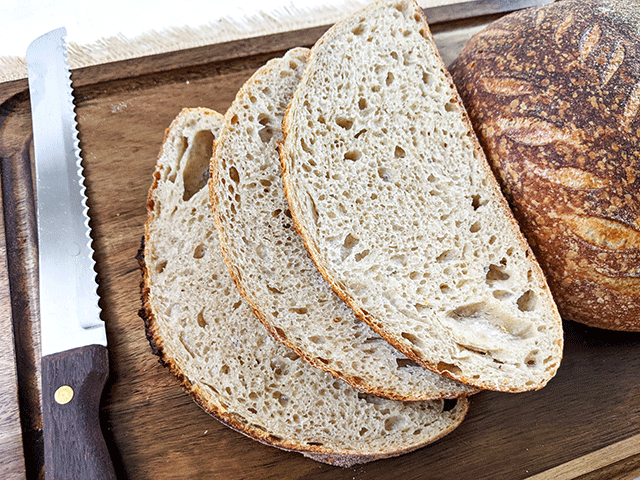
The rye and the wheat flours give this bread a full, rich flavor that pairs well with just about any sandwich fixing. Additionally, the all-purpose white flour makes the dough easy to work with – making it a good recipe for bakers who struggle with shaping artisan breads.
This white, wheat, and rye sourdough sandwich bread toasts beautifully, too. If you’re into grilled cheese and melts, this is the bread for you.
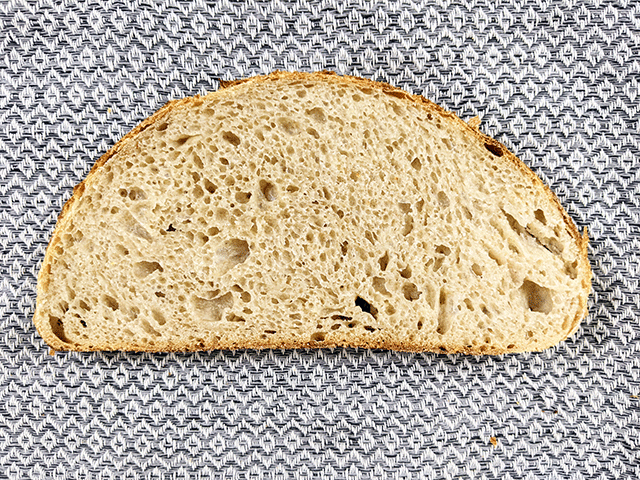
Although white, wheat, and rye sourdough bread takes several days to make, the extra time and effort is worth it. Also, most of that time is just letting the dough sit on the counter or sit in the fridge. For your convenience, I broke down the different bread making stages, so you can adjust the timing of your bread to fit your schedule.
Time
Prep time: 20 Minutes
Rise time: 20 to 24+ Hours
Cook time: 45 Minutes
Total time: 3 Days
Ingredients
To make white, wheat, and rye sourdough bread, you’ll need to make a levain the night before you mix your dough, as well as make the dough itself.
For the levain:
- 6 Grams (3/4 Teaspoon) Sourdough Starter
- 50 Grams (1/4 Cup + 2 Tablespoons) Whole Wheat Flour
- 60 Grams (1/4 Cup) Water
For the Dough:
- 350 Grams (2 3/4 Cups + 2 Tablespoons) Bread Flour *
- 50 Grams (1/4 Cup + 2 Tablespoons) Whole Wheat Flour
- 50 Grams (1/2 Cup) Rye Flour
- 345 Grams (1 1/4 Cup + 2 Tablespoons) Water
- 12 Grams (2 Teaspoons) Salt
Don’t have bread flour? You can make a bread flour substitute! Simply swap the bread flour for:
- 325 Grams (2 1/2 Cups + 3 Tablespoons) All-Purpose Flour
- 25 Grams (3 Tablespoons) Vital Wheat Gluten
If you don’t have bread flour or vital wheat gluten, you can just use regular all-purpose flour on its own. However, your bread may be more difficult to shape and the texture might not be as chewy.
Want to Scale the Recipe?
Here are the baker’s percentages:
- 76% Hydration
- 25% Levain
- 2% Salt
Feel free to bump up the hydration for a more open crumb. However, the higher you go, the more difficult your bread will be to shape. And you’ll need to adjust your rise times to accommodate the change. I tried to keep the hydration close to 75% as that is the easiest hydration for a beginner baker to work with, and it made the baker’s percentages easier to remember.
Additional Equipment
White, Wheat, and Rye Sourdough Bread does require a few kitchen basics to make:
- 4 Quart Container with Lid
- Kitchen Scale
- Measuring Cups and Spoons
- Dough Cutter/Bench Scraper
- Banneton Basket
- High Heat Parchment Paper
- Bread Lame
- 4-Quart Cast-Iron Dutch Oven
- Wire Cooling Rack
- Oven Mitts
Keep in mind that you can get creative with these tools. If you don’t have a bread lame, for example, a sharp knife or razor will do. If you don’t have a banneton basket, you could line a small round bowl instead.
As am Amazon associate, I do earn a small commission for qualified purchases. However, I do not get paid for my opinion, so I only recommend products I use and enjoy regularly.
Instructions
White, Wheat, and Rye Sourdough Bread does take a few days to make, so you might want to try this recipe on a weekend if you have a busy schedule. Fortunately, the first day requires almost no effort on your part.
Day 1 – Feed Your Starter and Make a Levain
For best results, you need an active, bubbly and regularly fed sourdough starter. If you don’t have a sourdough starter, you can learn how to make a starter here.
When I made this recipe, my sourdough starter consisted of whole wheat flour fed to 100% hydration. Essentially, this means I feed my starter 40 grams of whole wheat flour and 40 grams of water every morning at about 10:30 AM (because that’s what fits my schedule best).
To ensure your white, wheat, and rye sourdough bread goes smoothly, I suggest you feed your starter first thing in the morning. And then you make your levain at 10:30 PM that night. Simply combine your starter, flour, and water and that’s it for the first night!
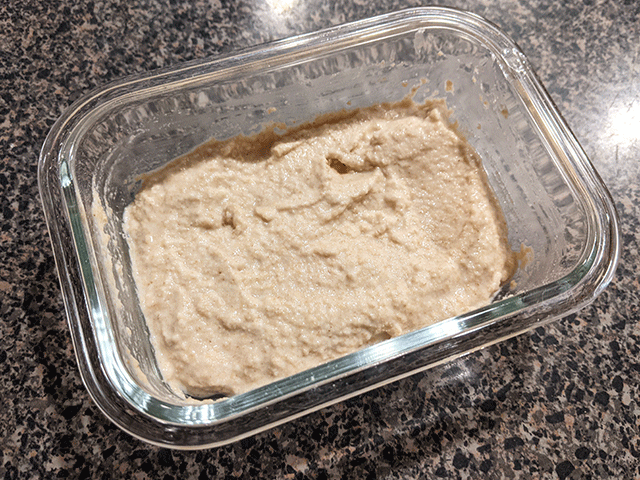
Cover and let your levain sit overnight on the counter. I keep my kitchen at about 68 degrees Fahrenheit (20 degrees Celsius) at this time of year, so keep that in mind if your kitchen is warmer or colder than mine.
Day 2 – Mix, Fold, and Shape Your Dough
Ready for day two of making white, wheat, and rye sourdough? Today’s the day you’ll do most of your work, and the majority of that work is just waiting.
10:30 AM – Autolyse
Wheat and Rye flours both absorb a lot of water, so your dough will need plenty of time to soak it in. First thing in the morning, combine your white, wheat, and rye flours with your water and mix it together until well incorporated.
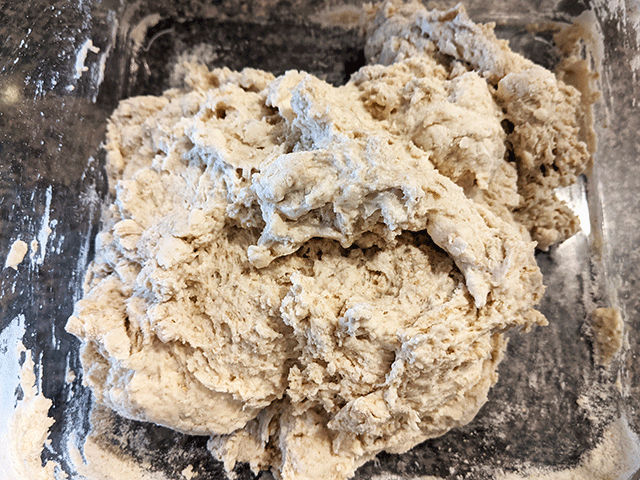
This initial dough will look shaggy and messy, but don’t worry. Everything will come together soon. Cover and let this mix sit for about 60 minutes.
11:30 AM – Add Your Levain
After you’ve let your dough autolyse for an hour, it’s time to add your levain. I like to dump it all on top of the dough and then fold the dough around it. During the mixing process, I wet my hands with water several times to keep the dough from sticking too much to my skin.
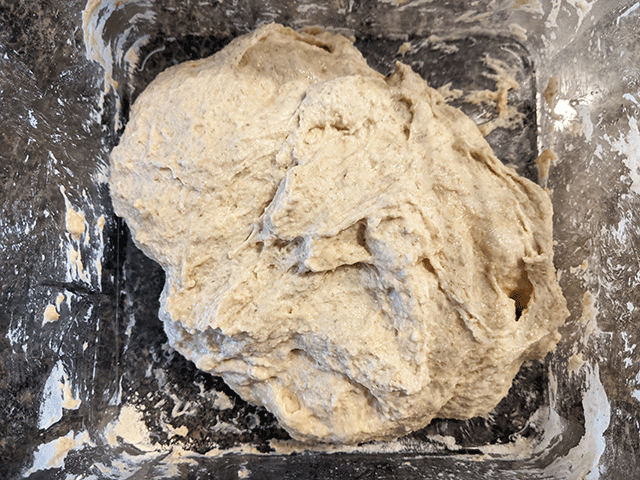
When the levain is fully incorporated into your dough, cover and let it rest again for 30 minutes.
12:00 PM – Add Salt
Your sourdough should start to look more like dough by now, a little less shaggy and a little more smooth. But it’s not quite done yet. Sprinkle the salt on top of the dough and then fold the dough around it, just like with the levain. Wet your hands a few times to keep the dough from sticking to you as you work the salt into the dough.
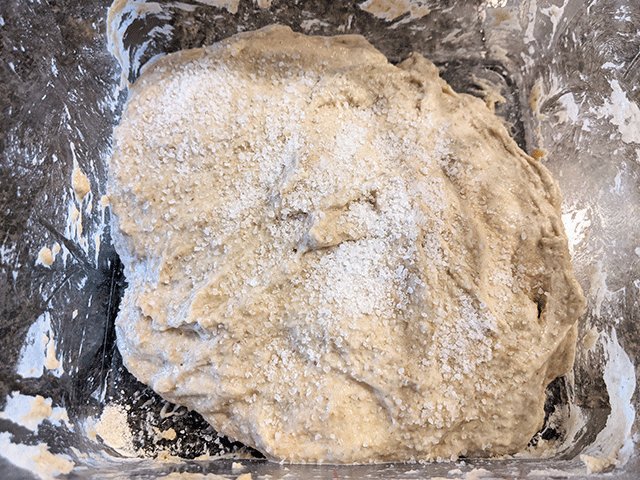
Once you’ve got the salt distributed throughout the dough, cover and let it rest for 30 minutes.
12:30 PM to 2:00 PM – Stretch and Fold Dough
White, Wheat, and Rye Sourdough bread is a high hydration dough. So you don’t knead it in the traditional sense. Instead of kneading, you’ll need to stretch and fold the dough several times to develop the gluten.
Wet your hands, and then grab a corner of your dough. Stretch the dough upward just until you meet resistance without breaking the dough.
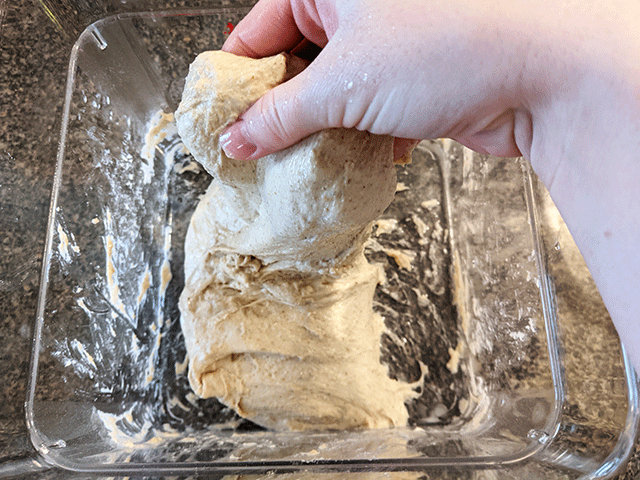
Then fold that corner of the dough over the top of the rest of the dough.
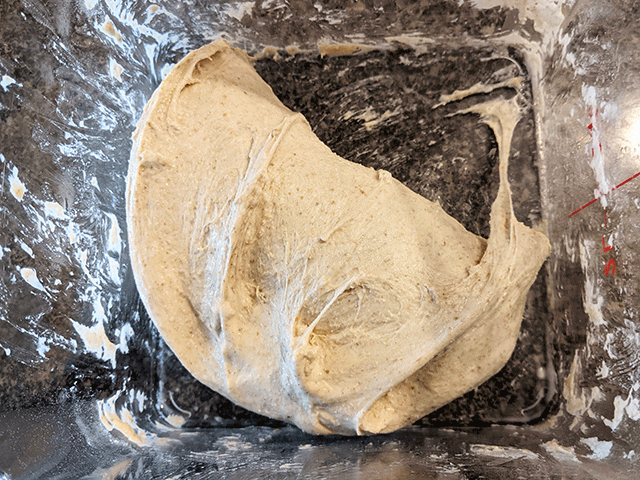
Rotate your dough about a quarter of a turn, and then repeat. Stretch and fold your dough until all corners of the dough have folded in on themselves. Your dough should somewhat like a round when you’re done folding.
Cover and let your dough rest for 30 minutes.
Then repeat this stretch-and-fold process. You’ll need to perform a series of 4 stretch-and-folds over the course of 2 hours with 30 minute breaks in between.
After you’ve finished stretching and folding your dough, cover and let it bulk rise for 5 1/2 hours. Keep in mind that you may need to adjust this fermentation time to account for your kitchen’s ambient temperature. When I made this recipe, my kitchen was 68 degrees Fahrenheit (20 degrees Celsius). If you have a warmer kitchen, you’ll need to cut the rise time. If you have a colder kitchen, you may need to extend your rise time.
7:30 PM to 8:00 PM – Preshape and Shape Dough
This is the possibly the most difficult step of making artisan sourdough bread. It’s a step that I still struggle with, and it takes a lot of practice to get right. A lot of professional bakers have different techniques for shaping, so you might need to find a technique that works best for you.
However, I find that the easiest method involves a bench scraper. You’ll need to work quickly and gently to keep the dough from sticking to your scraper.
To start, slide your bench scraper partway under your dough.

Then rotate it as you would a steering wheel. As you rotate you gently push into the dough to build tension.
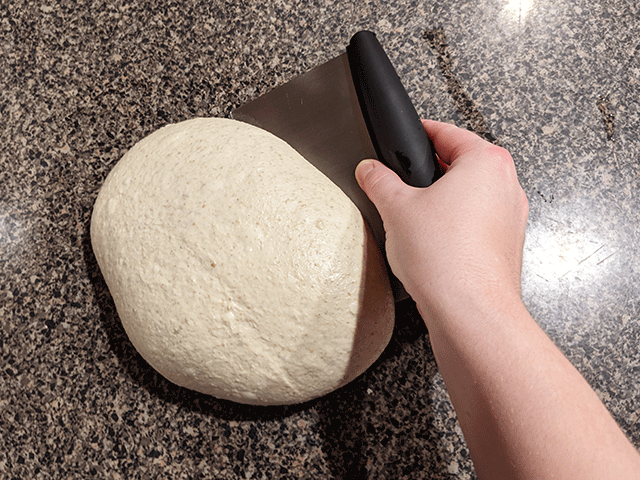
And repeat! Keep sliding, rotating, and pushing as you work your way around the dough. The goal is to build tension in your dough without breaking the outer skin. Eventually, you’ll end up with a little round like this one.
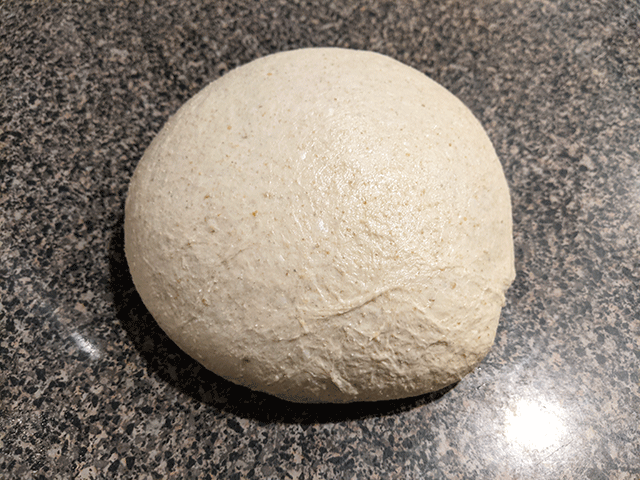
Let this round sit for 15 to 20 minutes. The dough will relax somewhat and lose its shape, which is why you’ll shape it again using the same method – slide, rotate, and push as you go.
8:00 PM – Retard in the Fridge
After you’ve shaped your dough for the second (and final) time, slide your bench scraper completely underneath your round and transfer it (seam side up) to a lined and lightly floured banneton basket. I prefer to use rice flour to keep my dough from sticking, but you could use regular bread flour or whole wheat flour if that’s what you have on hand.
If your dough seems a bit loose and struggling to hold its shape in the basket, you can grab some of the edges and bring them together, pinching the dough gently so it holds.

I know it’s a little hard to tell in the picture, but I tried and struggled to stitch and pinch my dough together with almost a zipper pattern. I’ve seen this technique work better with batards (elongated loaves) rather than boules (rounded loaves), and I’m not great at it. But it did seem to help hold my loaf together, or at least my efforts didn’t seem to have a negative effect on my final loaf.
Cover your dough and let it sit in the fridge over night.
Day 3- Bake Your Bread
Congratulations! You made it through day 2 of baking your white, wheat, and rye sourdough bread. You’re almost to the point where you can enjoy the fruits of your labor.
If you were to uncover your dough at this stage, you’d notice that your dough has relaxed somewhat in the fridge. A closer look and you can still see some of the stitching I attempted to do, but it’s sunk into the rest of the dough.

Also, the dough may have risen somewhat in the fridge over night as well, but not by much, a few millimeters at most. However, you can’t just pop it in the oven right now. If you did, you might end up with a loaf that sticks to your Dutch oven and doesn’t spring up as well as it should.
So leave your dough in the fridge until you are absolutely ready to bake – and by ready to bake, I mean preheating your oven and Dutch oven.
10:00 AM – Preheat Your Dutch Oven and Score Your Bread
First thing in the morning, you should preheat your oven to 475 degrees Fahrenheit (246 degrees Celsius) with your Dutch oven (and lid) inside.
You’ll need to preheat for a minimum of 45 minutes to an hour before baking to ensure your Dutch oven is hot enough to keep the dough from sticking.
A few minutes before you’re ready to bake, uncover your dough and flip it out onto a high-heat parchment paper. At this stage, the seams should be facing down on the parchment paper, and you’ll have a nice smooth surface for scoring your dough.

Use a bread lame to score your dough. If you don’t have a bread lame, a sharp knife or razor will do.
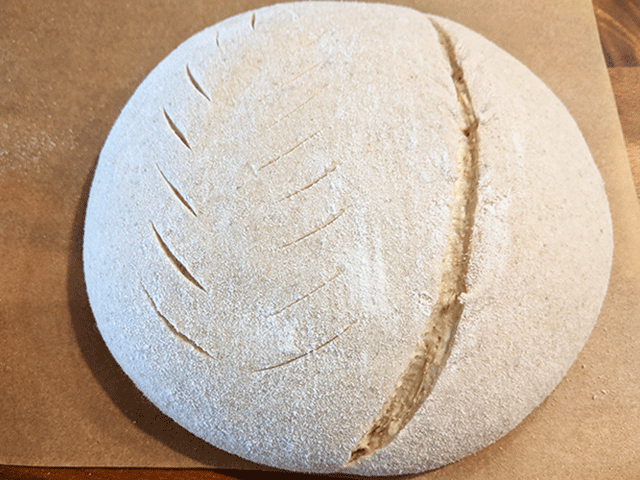
Ideally, you’ll want at least one deep slash to allow the steam to escape from your bread and give your bread room to spring up in the oven. If you’re looking for that baker’s ear on your loaf, you’ll need to angle your knife at about 45 degrees as you make your cut.
For best results, work with precise, smooth, steady movements. If you wobble too much, the edges will turn out jagged.
As you score your dough, keep in mind that the deeper the cut, the wider the loaf will pull at the cut. Smaller, decorative slashes should be relatively shallow, just enough to break the skin.
If you want to keep things simple, you can stick to just one deep slash, or you could make two slashes to make an X. Do whatever works for you.
11:00 AM to 11:45 – Bake Your Bread
Dough scored? Oven and Dutch oven preheated? You’re ready to bake!
Use the parchment paper to carefully transfer your dough to the Dutch oven. Toss in a crushed ice cube or two near the edges to give your bread some extra steam for a better oven spring.
Lower the temperature to 450 degrees Fahrenheit (232 degrees Celsius). Then cover and bake for 30 minutes.
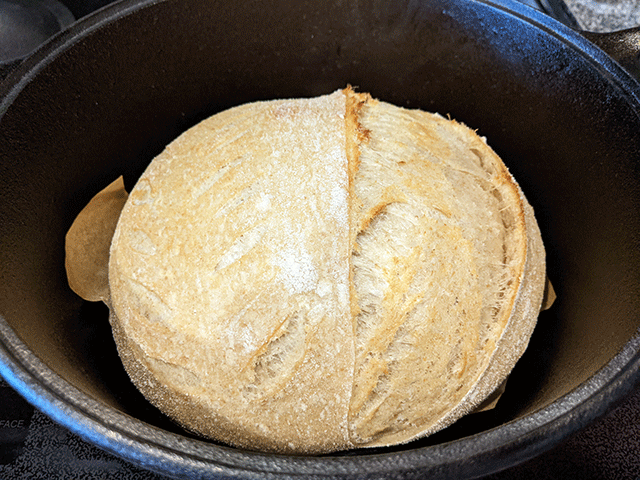
After 30 minutes, remove the lid to your bread – it should have sprung up beautifully at this point. But your bread isn’t done quite yet. Put the bread back into the oven for 15 to 17 minutes.
The crust will turn a nice deep brown color, and the bottom of the loaf will sound hollow when thumped. The darker the color, the deeper the flavor in the crust, so don’t be afraid to bake until your bread is just shy of burnt.
Turn the bread out onto a wire cooling rack to cool for at least an hour.
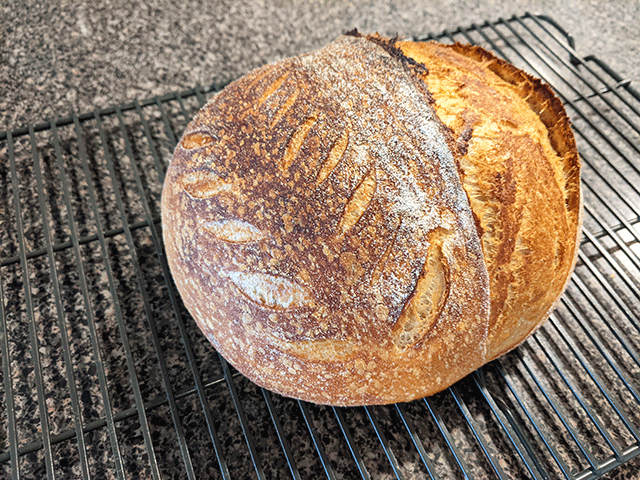
Wait for It to Cool
As tempting as it is to eat freshly made white, wheat, and rye sourdough right out of the oven, don’t cut into your loaf until it has completely cooled. The interior of your loaf will continue baking with its own residual heat. If you cut into it prematurely, the bread will have a gummy, spongey texture.
If you prefer a softer, chewier crust to a crunchy one, bag your loaf when it has cooled. The bread will still sweat, and the condensation will soften the crust. Again, don’t rush on the cooling here. If you prematurely bag your bread, the excess condensation will turn your bread soggy and mushy rather than simply softening.

Everything cool? You’re ready to slice and enjoy your bread. Homemade white, wheat, and rye sourdough bread can keep on the counter at room temperature for about 4 to 5 days. If the bread seems a little dry after the first two days, just pop it in the toaster to give it some crunch and refresh it a little.
Just the Basics

White, Wheat, and Rye Sourdough Bread
Ingredients
Levain
- 6 Grams Sourdough Starter (3/4 Teaspoon)
- 50 Grams Whole Wheat Flour (1/4 Cup + 2 Tablespoons)
- 60 Grams Water, Room Temperature (1/4 Cup)
Dough
- 350 Grams Strong Bread Flour (2 3/4 Cups + 2 Tablespoons)
- 50 Grams Whole Wheat Flour (1/4 Cup + 2 Tablespoons)
- 50 Grams Rye Flour (1/2 Cup)
- 345 Grams Water, Room Temperature (1 1/4 Cup + 2 Tablespoons)
- 12 Grams Fine Sea Salt (2 Teaspoons)
Instructions
Day 1
- 10:30 AM – Feed your sourdough starter.
- 10:30 PM – Combine starter, water, and flour to make your levain.
Day 2
- 10:30 AM – Combine flours and water to autolyse dough. Cover and lest rest 60 minutes.
- 11:30 AM – Add your levain to your dough and mix until well incorporated. Cover and let rest 30 minutes.
- 12:00 PM – Add salt to your dough and mix until well incorporated. Cover and let rest 30 minutes.
- 12:30 PM – Do your first stretch and fold. Cover and let rest 30 minutes.
- 1:00 PM – Do your second stretch and fold. Cover and let rest 30 minutes.
- 1:30 PM – Do your third stretch and fold. Cover and let rest 30 minutes.
- 2:00 PM – Do your last stretch and fold. Cover and let rest 5 1/2 hours.
- 7:30 PM – Pre-shape your dough. Let rest for 15 to 30 minutes.
- 8:00 PM – Shape your dough. Transfer dough to a lined banneton basket. Cover and place in the fridge overnight.
Day 3
- 10:30 AM – Preheat your oven to 475° Fahrenheit (246° Celsius) with Dutch oven inside.
- 11:30 AM – Turn dough out onto parchment paper and score.
- 11:35 AM – Carefully, transfer dough to Dutch oven. Add ice cubes. Cover with lid. Reduce heat to 450° Fahrenheit (232° Celsius) and bake for 30 minutes.
- 12:05 PM – Remove Dutch oven lid and continue baking for 15 minutes.
- 12:20 PM – Transfer loaf to wire rack to cool for 60 minutes.
- 1:30 PM – Slice, serve, and enjoy!
Notes
Secrets to Success
I absolutely love the flavor of this white, wheat, and rye sourdough bread. With practice, I found I could consistently make a loaf that looked as beautiful as it tasted.
However, I did have to make this recipe multiple times to get it just right.
They key to success was playing around with my fermentation times. The first time I made the recipe, I let it bulk for too long, about 6 1/2 hours rather than 5 1/2 hours. I had an open crumb, but the loaf itself wasn’t as tight and round as I had wished, and the loaf seemed to collapse on itself a little.
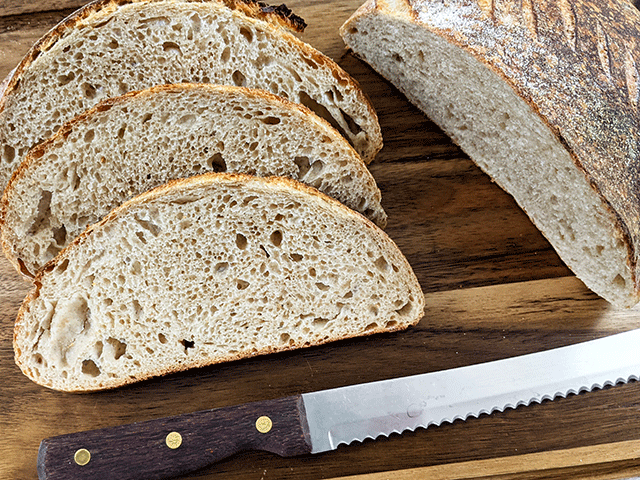
The second time I made this loaf, I cut the rise time to just 4 1/2 hours, and I loved the oven spring that I got from it. It kept its shape beautifully, and the loaf definitely looked great on the outside. But the crumb was tight, with almost no holes at all. And the flavor didn’t seem as developed as it had when I had gone with the longer rise time.
I ultimately played around with the timing of this loaf to see how far I could push the rise time (for better flavor and crumb) without sacrificing the structure of the loaf. With my particular kitchen and starter, that ideal time was 5 1/2 hours.
I understand that your kitchen might be different, so you may need to take notes with each time you make your loaf and see what gives you the best results.
Nutritional Information
White, wheat, and rye sourdough bread is as healthy as it is wholesome. Here’s the basic breakdown of the calories per serving:
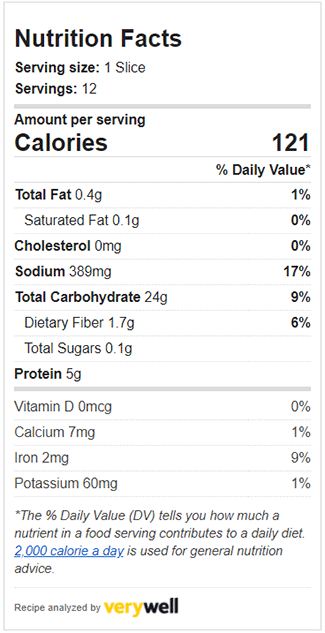
Of course, your serving per slice may vary somewhat, if you cut your slices thicker or thinner than mine. Keep that in mind if you like to track your calories like I do.
Did You Try It?
I love, love, LOVE this White, Wheat, and Rye Sourdough recipe. It’s definitely a new favorite of mine, but I know that making this bread is a time-consuming process. I’d love to know if you set aside a weekend to make my recipe, or if you have suggestions for improving my overall baking process. Let me know in the comments below!

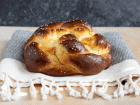

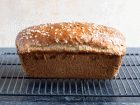
What was your room temp during bulk fermation?
Hey there, on average my kitchen temperature tends to range between 69 and 72 degrees depending on the season and time of day. For simplicity’s sake, I’d say 70 degrees is the average temperature.